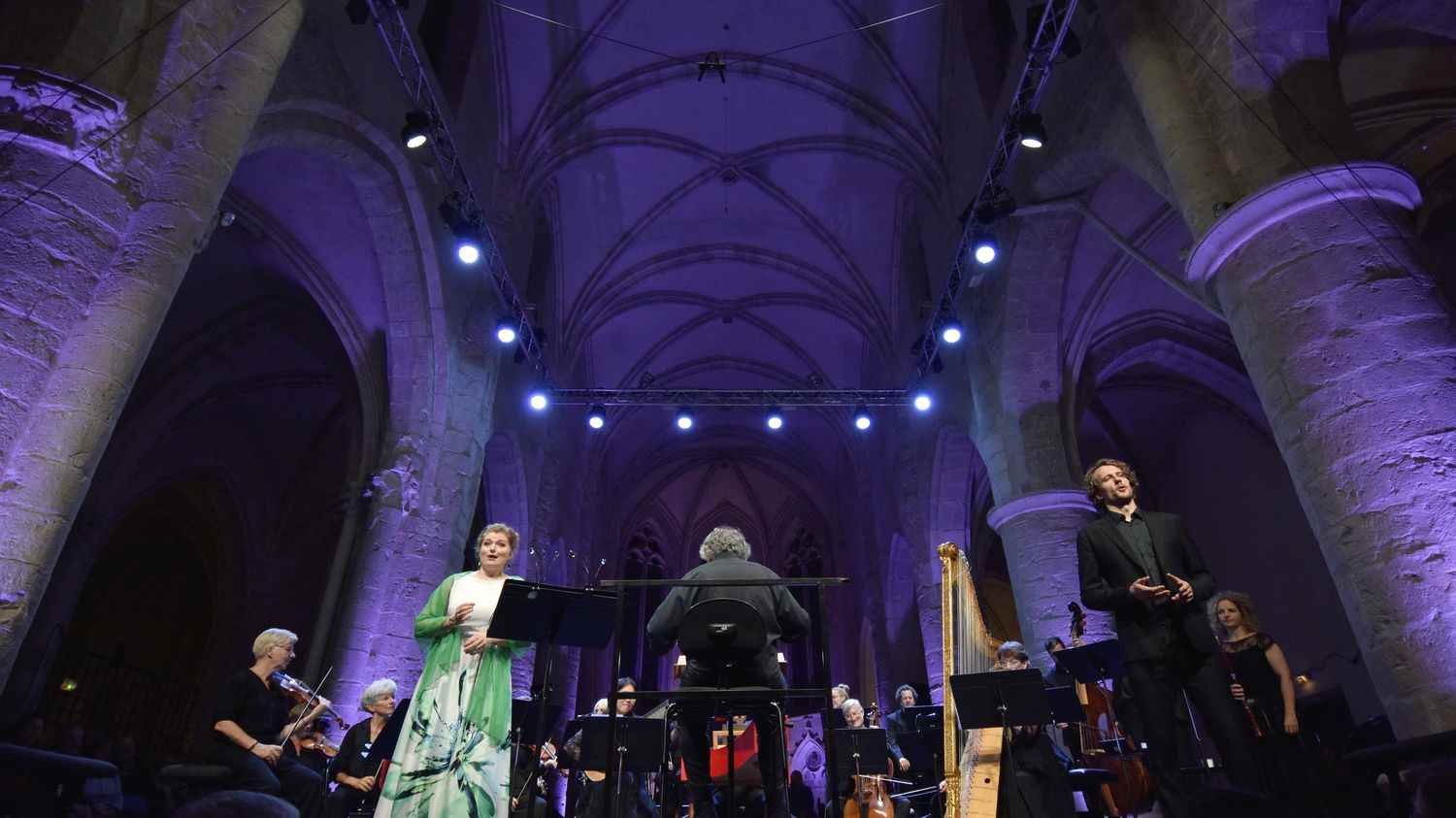In Ambronay, in the Ain, the Early and Baroque Music Festival, so firmly rooted in the territory, is expected as one expects a family celebration. And if the program and its novelties are scrutinized well in advance, its launch always arouses as much enthusiasm and reserves its share of surprises both musically and in terms of heritage. Story of a first night.
At the abbey, the stones took on color on this Friday, September 15, the opening night of the Baroque music festival. On the vast facades of the conventual buildings, a contemporary work in shades of blue, gray and sienna welcomes visitors, a unique monumental projection, created from a glass slide. Unlike modern video and LED lighting techniques, here the glass light signed by the master glassmaker Julien Guiler, offers an artisanal rendering, a nice dialogue between the material of the projected work and the architecture of the stones.

A sort of invitation to a new look at the site, in the tradition of the magic lantern, the work is part of the “monumental” theme given to this first weekend of the 43rd festival (which has four, up to to October 9). Monumental, in reference to the Heritage Days which are held as a tradition here too, and especially to the historical figures of Baroque music present, René Jacobs and Les Arts Florissants in the lead.
But let’s come back a little earlier in the evening, while the sun is still shining on the abbey: it is a small Spanish ensemble, Cantoria, which opens the festival with the concert at 6 p.m. in the Monteverdi room. The four young singers dazzled us in 2020 right here with their Iberian Renaissance polyphonies offered in a “spatialized” approach among the old stones of the abbey. Today their companionship with the festival has given rise to a record of “Ensaladas” (these same Spanish pieces with a tasty mix of styles and a cheerful tone) recorded on the prestigious Ambronay label.
But it’s a completely different repertoire that they offer in concert, the Madrigals of Monteverdi. Their choice fell on two laments from book 6 of the Madrigals, dating from 1614: this is the one which, without warning, will bring about a small revolution in the history of music, by highlighting the text, the speech, therefore, and the feeling expressed by poetry. And the feeling that prevails in the two laments, the famous Arianna’s Lament and The sestinais that of mourning and sadness in love.

“It’s not as happy as our Ensaladas”, humorously warns tenor Jorge Losana, who directs the ensemble, in front of the audience. The program (which also includes a section composed of passages from other books of madrigals by Monteverdi) combines a very modern score for the time and early, polyphonic music. Polyphony has no secrets for Cantoria and the ensemble seduces the spectators from the first lines of the “Lasciatemi morire” (“Let me die”), literally carried by the tragic tension of the story. The spectators are acquired, applauding wildly. The passage You slept, oh crudo cuore (excerpt from the 7th book) then above all, the lament The Sestina reveal on the other hand a more questionable phrasing and in particular too much vocal power deployed for such meditation. Finally, recognizing the faithful among the spectators, Cantoria ends their concert with the “hit” from their Spanish Renaissance repertoire, Sus, Sus, Susgreeted by a standing ovation from the audience.
The evening has only just begun: the highlight is the 8.30 p.m. concert at the abbey church, by the Orchester baroque de Friborg conducted by René Jacobs, one of the “popes” of the rediscovery of the Baroque movement and historical figure of the Festival d ‘Ambronay. On the program, two cantatas by Handel, one of his favorite composers. “Especially this Handel, from the Italian era, young and fiery”, immediately tells us the Belgian conductor before the concert. “Pure vocal and writing virtuosity”he adds.
And it is true that we are immediately struck by the brilliance of the first cantata, Il delirio amoroso, carried by a rich orchestration and the solidity of the German ensemble. The story: the young Chloris, upset by the death of her beloved Thyrsis, thinks she sees him and wants to join him, in a kind of amorous reverie, close to delirium. The Ukrainian soprano Kateryna Kasper quickly takes her marks and brilliantly leads the audience in her vocalizations and sustained notes. The second air Per te lasciai la luce (For you I left the light) gives chills. “Stop your uncertain step, or if you want to run away from me, at least tell me why”, continues the lonely young woman. The ensuing dialogue with the cello is poignant, while in the third air a brilliant soft flute gives the repartee.
Finally the bass baritone joins Kateryna Kasper in the cantata Apollo and Daphne where he marvelously interprets the arrogance of Apollo, sure of his charms. Believing himself invincible, and especially in love, he wants to conquer the beautiful nymph Daphne. “Please, let this inflexible severity soften”, implores Apollon in a magnificent duet. Daphne, unable to push him away, disappears by transforming into a laurel tree. Left alone, Apollo then lowers his voice: “If I can’t have you on my heart, Daphne, at least I will wear you on my forehead”. Yannick Debus interprets, calmed down, his most beautiful air which closes the cantata, applauded by the public of Ambronay.
